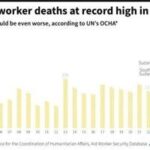Asian stocks experienced a mixed performance on Monday as investors reflected on the upcoming meeting of the Federal Reserve, following Wall Street’s best week since November with a slight uptick in U.S. stocks on Friday.
U.S. futures were higher while oil prices saw a decline.
In Japan, the benchmark index fluctuated in morning trading. The Nikkei 225 dropped 15.50 points to 38,047.17 after data revealed a 1.7% year-on-year decrease in core machinery orders for June. These orders are utilized as a leading indicator of capital spending in the upcoming six to nine months.
The U.S. dollar weakened to 146.44 Japanese yen from 147.58 yen.
The positive U.S. retail sales figures from last week heightened market confidence and shifted sentiment regarding potential interest rate cuts by the Federal Reserve in September, which could lead to a sell-off of the yen against the dollar and other major currencies. However, the dollar-yen exchange rate has been on a downward trend in recent weeks.
Luca Santos, a currency analyst at ACY Securities, noted, “The recent turmoil in the foreign exchange market isn’t just about the Bank of Japan’s actions … other factors, like signals from the Federal Reserve about possible rate cuts, weak U.S. job market data, and broader global economic uncertainties, have also contributed to the recent turbulence.”
The focus of the market is on Jackson Hole, Wyoming, where Federal Reserve Chair Jerome Powell will deliver a speech later in the week. This location has been known for significant policy announcements in the past.
Considering that the Fed’s upcoming decisions will be heavily influenced by future data reports, economists at Deutsche Bank, led by Matthew Luzzetti, believe that “it will be difficult for Powell to pre-commit to a particular trajectory at Jackson Hole.”
While Powell might offer clues about the Fed’s intentions of either removing economic restraints through rate cuts or providing an economic stimulus, uncertainties prevail.
In other parts of Asia, the S&P/ASX 200 in Australia rose by 0.2% to 7,988.00 and the Kospi in Seoul saw a 0.2% decline to 2,690.83. Hong Kong’s Hang Seng rose by 1% to 17,611.77, while the Shanghai Composite increased by 0.5% to 2,894.57.
Bangkok’s SET index posted a gain of 0.8% after reports showed a 2.3% year-on-year increase in the country’s gross domestic product for the second quarter, primarily driven by tourism.
On Friday, the S&P 500 recorded a 0.2% increase to 5,554.25 for a seventh consecutive gain, nearing its all-time high set last month. The Dow Jones Industrial Average also saw a 0.2% gain to 40,659.76, while the Nasdaq composite added 0.2% to 17,631.72.
In the bond market, Treasury yields saw a slight decrease following mixed reports on the U.S. economy. The shift in sentiments was triggered by a report showing fewer housing projects started last month than expected, cooling down optimism that had been building earlier in the week.
However, an optimistic report later in the morning suggested that U.S. consumers are feeling more positive about the economy than anticipated, which is crucial for Wall Street given their significant contribution to the economy through spending.
Despite the recent confidence in economic strength, the economy is still believed to be slowing down due to high interest rates. The key question remains whether this slowdown will deepen into a recession. The expectation on Wall Street is that an impending cut in interest rates at the Fed’s forthcoming meeting in September will help prevent this scenario.
In energy trading, U.S. crude oil declined by 16 cents to $75.38 per barrel, while Brent crude lost 15 cents to $79.53 per barrel.
The euro showed strength against the U.S. dollar, costing $1.1040 on Monday as compared to $1.1028 previously.
AP Business Writer Stan Choe contributed to this report.
Copyright 2024 The Associated Press. All rights reserved. This material may not be published, broadcast, rewritten, or redistributed without permission.





